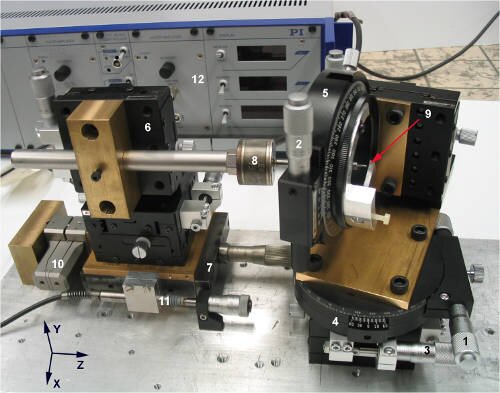Point indentator

An assembly of X, Y and Z translation stages (1,2,3) and two orthogonally nested rotation stages (4,5) position the specimen in the field of view of a structured light profilometer, and determine the indentation angle.
The back part of the indentation apparatus is composed of a second X–Y–Z translation stage (6), placed on top of a larger Z-translation stage (7). This carries the indentation needle (9) with force transducer (8). This indentation stage is driven by a high voltage piëzo actuator (10) [P-290 Long-Travel Piezoelectric Stage Actuator PI Polytec] and its position monitored with a linear variable differential transducer (11) [Spring Push Gage Probe Solartron] in a feedback control loop of a piëzo driver unit (12) [E509 Servo-Control Module + E507 Piëzo Amplifier Module PI Polytec].
The indentation can be performed over a distance up to 1000 µm with an accuracy of 1 µm. The indentation force acting upon the indentation needle is measured using a piëzo-resistive load cell (9) [Force Transducer model 31 Sensotec] measuring forces with a precision of 1 milliNewton.
For a detailed description:
J.A.N. Buytaert, J.E.F. Aernouts, and J.J.J. Dirckx, ‘Indentation measurements on the eardrum with automated projection moiré profilometry’, Optics and Lasers in Engineering 47(3-4): 301-309, 2009.
doi:10.1016/j.optlaseng.2008.01.002